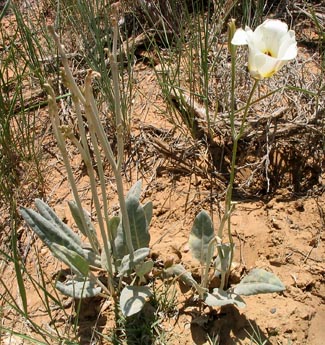Sego Lily

Common Name(s):
Sego Lily
Scientific Name:
Calochortus nuttallii Torr. & Grau
Scientific Name Synonyms:
None known
Symbol:
CANU3
Description:
Life Span: Perennial
Origin: Native
Season: Cool
Growth Characteristics: A monocot with a single stem and having a single, large, terminal flower. This plant is one of the most conspicuous and beautiful early-blooming flowers of the semidesert. It dries up shortly after blossoming.
Flowers/Inflorescence: Goblet shaped, satin-like flowers. The flower is white with cherry red and yellow markings at the base (glands). The flowers can be up to 3 inches across.
Fruits/Seeds: Fruit is a capsule, which splits open along partitions, with numerous flattened seeds inside.
Leaves: Sego lilies have a few basal grass-like leaves, and leafy stems. It can be distinguished from death camas (prior to flowering) by the rounded trough-like cross section of their U-shaped leaves, as opposed to the sharply V-shaped leaf of deathcamas.
Ecological Adaptions:
Sego lily occurs on the open sagebrush foothills and valleys, as well as in open ponderosa pine stands at moderate elevations.
Soils: It thrives on rather dry, sandy soils.
Associated Species: Sagebrush, ponderosa pine, death camas, lupine.
Uses and Management:
The forage value of sego lily is limited, chiefly due to the small amount of herbage and the sparseness of the stands. When eaten, the palatability of the herbage is good for sheep and fair for cattle. Horses do not graze it. The bulbs are eaten, and also gathered and stored by pocket gopher and other rodents.
Western Indians deemed the bulb-like roots of sego lily a great delicacy. They taught the Mormon pioneers to use the bulb for badly needed food. This resulted in the sego lily being designated as the Utah State Flower.

